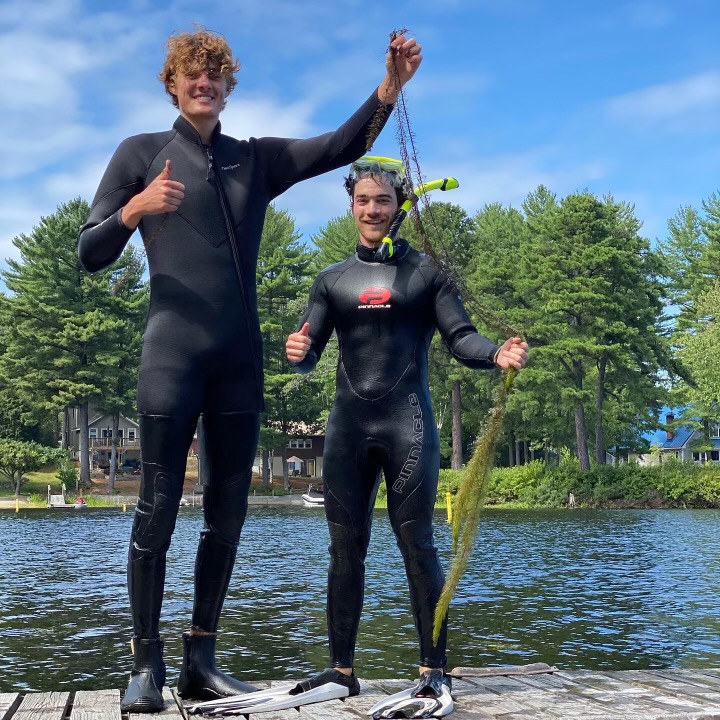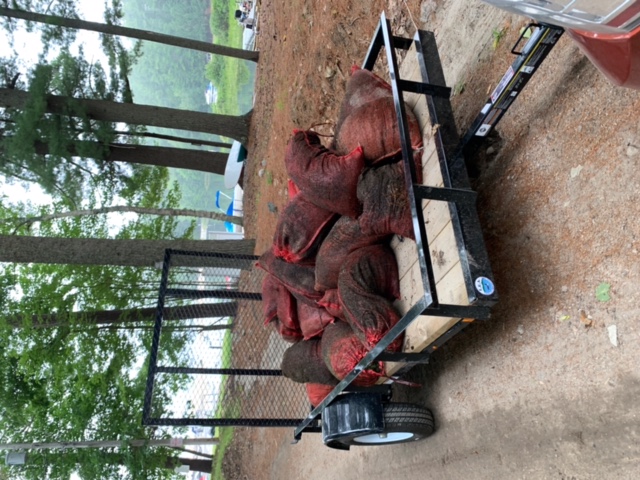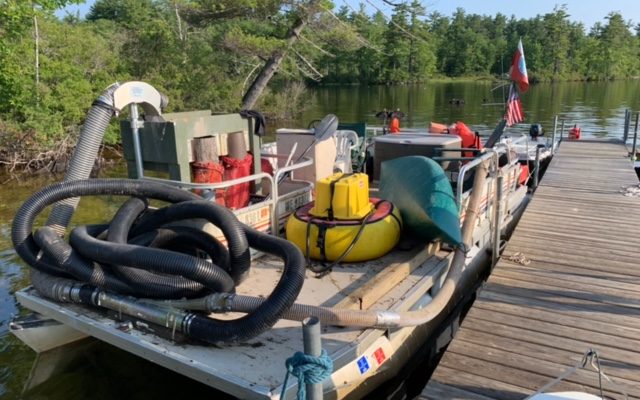by Logan Hagerty
During the summer of 2021, our oldest son, Logan, worked for the Lakes Environmental Association (LEA) on a milfoil removal crew. He drafted the following operational narrative of LEA’s efforts to mitigate a Eurasian milfoil infestation that was discovered on Long Lake. I hope you will find his story to be both interesting and useful. It is a cautionary tale. Please continue to spread the word about the importance of protecting our beautiful Moose Pond from all invasive plants and animals.
shawn hagerty • middle basin resident • mpa board member since 2021 • 2 years on the lake
Sea-sledding is an effective way to scout for invasive plants, like Eurasian milfoil, that have made their way into Maine’s lakes. This activity typically requires three or four workers, one boat, one rope, and a sea sled. Once snorkeled-up, a wetsuit-wearing volunteer hops into the water, and is then dragged behind the boat at a speed slow enough (typically 2-4 mph) to allow the sledder to maintain control while patiently scanning the under-water plant life. One person drives the boat, and another spots.
A sea sled is a custom board, much like a kickboard, which the diver holds onto. Angling the board up and down allows the diver to descend or ascend as they like. After a couple of days on the job, it is easy for any sea-sledding volunteer to identify the light-green, red-stemmed, feathery-tendrilled culprit – Eurasian milfoil. Since Eurasian milfoil is most often found at a depth shallower than 15 feet, sea-sledding is best performed close to the shoreline and we often find ourselves operating in the space between a homeowner’s mooring buoy(s) and dock. In areas where sea sledding is not possible (like a marina or swim area) it is important for milfoil divers to carefully check under boat props and between slips. One person in each milfoil crew acts as a spotter and should always be kayaking in and around the divers. This ensures extra safety for the divers, and also makes the spotter available to answer questions that we frequently get from curious property owners like — “What’re you looking for, sunken treasure?”
When a diver encounters Eurasian milfoil, there are a variety of methods for safely attempting the plant’s removal. The priority recommendation is to call the Lakes Environmental Association (LEA). This outreach to LEA is really important because LEA dive crews are trained in effective milfoil identification and removal practices and have specialized equipment to do so safely. Improper or incomplete removal of milfoil can lead to the creation of “frags,” or miniscule sections of milfoil, that brake off and easily create new patches, as far away as the frags can float (which can be really, really far). If there are only a few plants, it is possible to use hand removal, by carefully pulling the plant up from its roots. If a dive crew finds a medium- size patch, oftentimes they opt to use a plant suction harvester. You might have spotted this harvesting machine built into some of LEA’s boats, with its characteristic black coiled tube.
While it is satisfying to smother milfoil, seeing areas where milfoil has completely overtaken native vegetation is heartbreaking…
To use the harvester, the first step is, not surprisingly, to prepare the divers for harvesting. Two divers will use a Brownie’s Third Lung™, which sends compressed air through 20-foot yellow hoses to the divers’ breathing regulators. Some dive crews have full-face communication masks, which allows for natural breathing through the nose, and also audio communication through a COMM box on the boat. This communication is useful to warn divers of oncoming boat traffic, or in case the suction harvester machine gets jammed. Next, the two divers put on weight belts, grasp the handle of the suction hose, and descend underwater. Approaching the milfoil patch, divers must step or swim carefully, to avoid mucking up the visibility. Plants are pulled and sent through the suction hose onto a trough on the boat, which is manned by another member of the crew. This trough separates plants and mud, and plants are collected in mesh bags or plastic buckets.
Some dive crews deal with areas that are completely infested by Eurasian milfoil. In Sebago Cove, for example, milfoil is easily visible to anyone on a boat. It is scary to see the milfoil tendrils growing and coiling on the surface of the water. The milfoil crew in this particular cove spends a lot of time diving, harvesting, and laying benthic barriers to kill large swaths of milfoil at a time. Benthic barriers are enormous tarps interlaced with pieces of rebar. These barriers are hand-laid or removed by dive crews in depths ranging from a couple feet deep to more than a dozen feet below the surface.
While it is satisfying to smother milfoil, seeing areas where milfoil has completely overtaken native vegetation is heartbreaking for so many reasons, both from an ecological and recreational point of view.
In certain areas, there is so much milfoil that local homeowners sponsor the LEA to remove milfoil that has infested the shoreline of their property. This “sponsorship” is increasingly necessary as the costs associated with the fuel, staffing and equipment needed to successfully remove milfoil is financially demanding for nonprofits.
Prevention is key and the greatest opportunity to wage war against milfoil. It is tempting to end this article saying there is hope for areas like Sebago Cove, where milfoil has completely spread. However, after spending close to fifty full days this summer removing milfoil, simply suggesting such hope seems irresponsible. Unless something drastic is done, the situation there does not seem like it will improve. The LEA has a proven record of successfully removing milfoil in some of Maine’s lakes, and is working around the clock to protect our lakes. Still, it is impossible to ignore the effects of invasive milfoil once it has completely overtaken an aquatic environment. We should never let milfoil take hold in any more lakes.
Every year, MPA pays LEA to perform an invasive plant survey to scout for Eurasian milfoil & other unhelpful aquatic plants and animals …
As a milfoil diver harvesting underwater in a milfoil-infested cove, it was eerie and unnerving to only see mud, and come to know the feeling of milfoil by touch alone. Some bodies of water. like Moose Pond, have native milfoil. This native species of milfoil doesn’t overtake other aquatic plants or grow in the reckless and characteristic positive feedback loop of invasive Eurasian milfoil. Rather than hope for a continued ecological balance, prevention and education is the best way we can keep our Maine lakes safe. Whether this means paying courtesy boat inspectors, sponsoring dive surveys or being in close communication with the LEA, we must ensure invasive milfoil does not continue to take root in our waters. It is easy, crucial, and mutually beneficial to become a member of the LEA; the LEA is member-funded and brings its members’ concerns at the state level, in addition to providing local water testing and education services.
Every year, the Moose Pond Association pays LEA to perform an invasive plant survey to scout for Eurasian milfoil and other unhelpful aquatic plants and animals in what we have jointly identified as the lake’s most vulnerable “hot spots.”
For entertaining media illustrating suction harvester removal of milfoil and sea sledding, see the LEA YouTube page (Lakes Environmental Association). Also, make sure to shoot the LEA a “follow” on Instagram (@lakesenvironmental) or Facebook (Lakes Environmental Association) to see just how dedicated these milfoil crews are!

logan (with mask and snorkel) and colleague holding freshly removed milfoil plant. 
bags of removed milfoil for disposal

